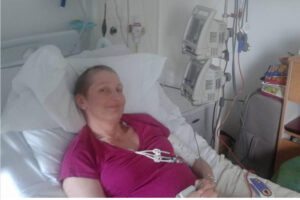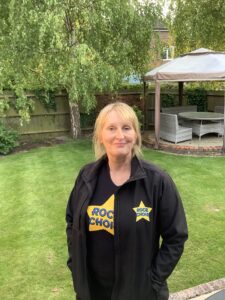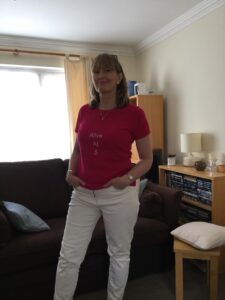
12 May 2025
Jude’s story: Giving hope to others diagnosed with leukaemia
“At approximately 1.30am on the Saturday night/Sunday morning my husband and I were awoken by the phone ringing. It was a doctor asking him to take me straight to A&E…….I cannot put into words the shock and fear that we both felt, driving to our local hospital not knowing what was to come.”
“I had a cold I just couldn’t shift and was feeling a bit tired” said Jude Mulcahy, now 57, a retired primary school teacher who lives in Broadstairs in Kent. “But it was no more than usual for that busy time of the school year. During half term I decided to go to the doctor. He said to be on the safe side let’s get a blood test. I was going to put it off until the summer holidays but I decided to just get it out the way. That was the Friday afternoon.
“At approximately 1.30am on the Saturday night/Sunday morning my husband and I were awoken by the phone ringing. It was a doctor asking him to take me straight to A&E where a team would be waiting for me. They said: ‘Your wife is very ill’. I cannot put into words the shock and fear that we both felt, driving to our local hospital not knowing what was to come. The situation was exacerbated by the fact we were not told which hospital to go to and had gone to the wrong one first. But eventually we got to the right place which was the Kent and Canterbury Hospital.”
After more tests, on Sunday 2nd June 2013 doctors confirmed that Jude had acute myeloid leukaemia (AML).
“That bit is a blur looking back as I was in shock. I just remember lots of tests and waiting around. I didn’t know what AML was. But they immediately told me they were going for the cure, so they were positive right from the start and that helped. Bizarrely I remember thinking ‘leukaemia’ was a pretty word for a cancer. And then I thought about losing my hair. I’d just had expensive highlights done and felt it would be such a shame to lose it all now!
“In the end I didn’t go home for over two months. I had to give my husband instructions on where to get all my things around the house to bring to me. But the hospital and everyone on Brabourne Ward were just incredible. There was a garden outside that I could sit in and it really was a very safe and comfortable place to be.
 “When I started to lose my hair my hairdresser came to the hospital. First she did a short pixie cut and then a couple of weeks later the full shave. She’s been doing my hair since I was 20 and we have quite a bond now since that time. I would say to anyone frightened of losing their hair, the dread is awful but when it actually happens it’s so much easier than you think. I just felt once it was done, the next thing that would happen would be for it to grow back and every day was a step closer to that.”
“When I started to lose my hair my hairdresser came to the hospital. First she did a short pixie cut and then a couple of weeks later the full shave. She’s been doing my hair since I was 20 and we have quite a bond now since that time. I would say to anyone frightened of losing their hair, the dread is awful but when it actually happens it’s so much easier than you think. I just felt once it was done, the next thing that would happen would be for it to grow back and every day was a step closer to that.”
Jude had four rounds of chemotherapy across six months, both in the hospital and at home. In December she was given the wonderful news that she was in remission, only to have her hopes dashed in February 2014 when a follow-up blood test revealed her leukaemia had returned.
“I’d briefly gone back to work and had enjoyed Christmas at home. I was devastated. But looking back on it I don’t think it ever really fully went away, the cells were just hiding somewhere.”

Jude with a wig at her nephews wedding during treatment with her husband and step daughters
“I was told I would need a stem cell transplant. They basically said ‘If we don’t do it you will die, if we do you still might’. I was very scared. I was referred to Kings Hospital in London which seemed so massive and busy and intimidating after Kent and Canterbury. But they gave me a lovely room with a picture of the sea – as I live in a seaside town that meant a lot to me.
“On 24th June 2014 I had my transplant. I now consider to be my other birthday! My husband wasn’t due to visit but turned up at the hospital as a surprise. I stayed in hospital for three weeks. My only side effect was a few mouth ulcers. I really had the most incredibly easy recovery – doctors were amazed.”
Physically Jude recovered so well that she says she now feels “exactly the same as I did before my leukaemia”. In March 2014 she had a phased returned to work and was soon back in the demanding job of full-time teaching.

“Recovering mentally was much harder than physically. I couldn’t get my head properly around what had happened. I ended up having some counselling and the counsellor put it down to the shock call in the middle of the night. I’d had a few of those before and they were always bad – like when I was told my mum was dying. She said the mind takes a lot longer to heal. But it did. And physically I am so lucky to have remained well. In one of my recent check-ups the doctor was very encouraging and said that each year the chances of it returning became less and less.
“One of the things that has really helped me in my recovery is joining Rock Choir. The healing power of singing is a wonderful thing and singing and laughing with others is amazing. It has given me back a lot of confidence and I have made some lovely friends.”
After early retirement at Christmas 2024, Jude is focusing on her family, her community, her health and spreading the word about the importance of leukaemia care and research.
 “Everyone involved in my care was absolutely fantastic. My husband Mark, my family, friends and Christian faith helped me get through it. Also saying to myself that every day was a day nearer to being well and ‘normal’ again. Anthony Nolan and my anonymous donor saved my life. Stem cell transplants are extraordinary and I’m now passionate in doing all I can to give hope to others who’ve been diagnosed with leukaemia.”
“Everyone involved in my care was absolutely fantastic. My husband Mark, my family, friends and Christian faith helped me get through it. Also saying to myself that every day was a day nearer to being well and ‘normal’ again. Anthony Nolan and my anonymous donor saved my life. Stem cell transplants are extraordinary and I’m now passionate in doing all I can to give hope to others who’ve been diagnosed with leukaemia.”
Related posts
12 June 2021
First Medical Research Council and Leukaemia UK Clinical Research Training Fellow shares project highlights
Dr Sandeep Potluri’s findings will contribute towards a better understanding, cure and treatments of leukaemia and blood cancers
18 November 2024
Leukaemia UK’s Patient Care Pioneer Award fuels innovative research to revolutionize ‘watch and wait’ approach
Leukaemia UK is excited to announce Professor Francesco Forconi from University Hospital Southampton (UHS) as the first recipient of its Patient Care Pioneer Award. Through this new funding initiative, Professor…
19 August 2022
Leukaemia Care and Leukaemia UK announce financial support collaboration
Leukaemia Care and Leukaemia UK are pleased to announce a collaboration to provide financial support to people affected by leukaemia, through the financial hardship fund. Leukaemia Care have provided 364…
30 January 2024
Leukaemia UK bolsters research and advocacy team, in support of ambitious strategy to accelerate progress in the diagnosis, treatment, and care of leukaemia
Leukaemia UK is pleased to announce Dr Simon Ridley as the new Director of Research and Advocacy and Dr Georgia Papacleovoulou as the organisation’s first ever Head of Policy and…